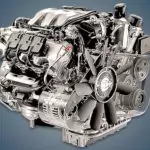The Chrysler EGG 3.5-liter 24-valve V6 engine was produced from 1998 to 2010 and equipped models on the LH and LX platforms, such as 300C, 300M, LHS, Concorde and Charger. There was a slightly less powerful version of the EGJ unit and a slightly more powerful modification of the EGK.
The LH series also includes internal combustion engines: EER, EGW, EGE, EGF, EGN, EGS and EGQ.
The engine was installed on:
- Chrysler 300C 1 (LX) in 2004 – 2010;
- Chrysler 300M 1 (LR) in 1998 – 2004;
- Chrysler Concorde 2 in 2001 – 2004;
- Chrysler LHS 1 in 1998 – 2001;
- Dodge Charger 1 (LX) in 2005 – 2010;
- Dodge Challenger 3 (LC) in 2008 – 2010;
- Dodge Intrepid 2 (LH) in 1999 – 2004;
- Dodge Magnum 1 (LE) in 2004 – 2008;
- Plymouth Prowler 1 in 1999 – 2002.
Specifications
| Production years | 1998-2010 |
| Displacement, cc | 3518 |
| Fuel system | injector |
| Power output, hp | 250 |
| Torque output, Nm | 340 |
| Cylinder block | aluminum V6 |
| Block head | aluminum 24v |
| Cylinder bore, mm | 96 |
| Piston stroke, mm | 81 |
| Compression ratio | 10.1 |
| Features | SOHC |
| Hydraulic lifters | yes |
| Timing drive | belt |
| Phase regulator | no |
| Turbocharging | no |
| Recommended engine oil | 5W-30 |
| Engine oil capacity, liter | 5.2 |
| Fuel type | petrol |
| Euro standards | EURO 3 |
| Fuel consumption, L/100 km (for Chrysler 300M 2000) — city — highway — combined |
16.3 8.7 11.5 |
| Engine lifespan, km | ~340 000 |
Disadvantages of the EGG engine
- The narrow oil channels of the engines of this series quickly become slagged. This turns into oil starvation of the motor, wear of the liners, and so on;
- Compression drops are also common due to exhaust valve deposits;
- Throttle and EGR valve contamination leads to floating idle;
- Another weak point of the unit are regular leaks of oil and antifreeze.






